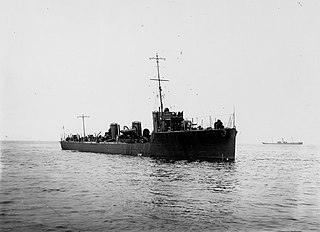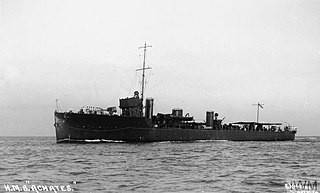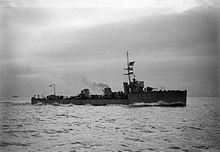
The Battle of Jutland was a naval battle fought between Britain's Royal Navy Grand Fleet, under Admiral Sir John Jellicoe, and the Imperial German Navy's High Seas Fleet, under Vice-Admiral Reinhard Scheer, during the First World War. The battle unfolded in extensive manoeuvring and three main engagements, from 31 May to 1 June 1916, off the North Sea coast of Denmark's Jutland Peninsula. It was the largest naval battle and the only full-scale clash of battleships in that war. Jutland was the third fleet action between steel battleships, following the Battle of the Yellow Sea in 1904 and the Battle of Tsushima in 1905, during the Russo-Japanese War. Jutland was the last major battle in history fought primarily by battleships.

The Battle of Heligoland Bight was the first Anglo-German naval battle of the First World War, fought on 28 August 1914, between ships of the United Kingdom and Germany. The battle took place in the south-eastern North Sea, when the British attacked German patrols off the north-west German coast. The German High Seas Fleet was in harbour on the north German coast while the British Grand Fleet was out in the northern North Sea. Both sides engaged in long-distance sorties with cruisers and battlecruisers, with close reconnaissance of the area of sea near the German coast—the Heligoland Bight—by destroyer.

The Battle of Dogger Bank was a naval engagement during the First World War that took place on 24 January 1915 near the Dogger Bank in the North Sea, between squadrons of the British Grand Fleet and the Kaiserliche Marine. The British had intercepted and decoded German wireless transmissions, gaining advance knowledge that a German raiding squadron was heading for Dogger Bank and ships of the Grand Fleet sailed to intercept the raiders.

HMS Inflexible was one of three Invincible-class battlecruisers built for the Royal Navy before World War I and had an active career during the war. She tried to hunt down the German battlecruiser SMS Goeben and the light cruiser SMS Breslau in the Mediterranean Sea when war broke out and she and her sister ship Invincible sank the German armoured cruisers SMS Scharnhorst and SMS Gneisenau during the Battle of the Falkland Islands. Inflexible bombarded Turkish forts in the Dardanelles in 1915, but was damaged by return fire and struck a mine while maneuvering. She had to be beached to prevent her from sinking, but she was patched up and sent to Malta, and then Gibraltar for more permanent repairs. Transferred to the Grand Fleet afterwards, she damaged the German battlecruiser Lützow during the Battle of Jutland in 1916 and watched Invincible explode. She was deemed obsolete after the war and was sold for scrap in 1921.

HMS Invincible was the lead ship of her class of three battlecruisers built for the Royal Navy during the first decade of the twentieth century and the first battlecruiser to be built by any country in the world. During the First World War, she participated in the Battle of Heligoland Bight in a minor role, as she was the oldest and slowest of the British battlecruisers present. During the Battle of the Falkland Islands, Invincible and her sister ship Inflexible sank the armoured cruisers Scharnhorst and Gneisenau almost without loss to themselves, despite numerous hits by the German ships.
This is the complete order of battle for the Battle of Jutland fought between 31 May and 1 June 1916. The battle involved 250 warships of the British and German navies, and, in terms of combined tonnage of vessels engaged, was the largest naval battle in history.

HMS Ambuscade was an Acasta-class destroyer of the Royal Navy and was launched in 1913. She served throughout the First World War, forming part of the Grand Fleet and taking part at the Battle of Jutland, serving in the Dover Patrol and spending the latter part of the war as a convoy escort. She was sold for scrapping in 1921.

SMS Moltke was the lead ship of the Moltke-class battlecruisers of the German Imperial Navy, named after the 19th-century German Field Marshal Helmuth von Moltke. Commissioned on 30 September 1911, the ship was the second battlecruiser of the Imperial Navy. Moltke, along with her sister ship Goeben, was an enlarged version of the previous German battlecruiser design, Von der Tann, with increased armor protection and two more main guns in an additional turret. Compared to her British rivals—the Indefatigable class—Moltke and her sister Goeben were significantly larger and better armored.

HMS Acasta was one of eight A-class destroyers built for the Royal Navy (RN) in the 1920s. The ship spent most of the 1930s assigned to the Mediterranean Fleet. During the early months of the Spanish Civil War of 1936–1939, Acasta spent considerable time in Spanish waters enforcing the arms blockade imposed by Britain and France on both sides of the conflict.

The Acasta class was a class of twenty destroyers built for the Royal Navy under the Naval Programme of 1911 - 1912 that saw service during World War I. They were the last class of Royal Navy destroyers to have mixed names with no systematic theme When the class was designated as "K", names beginning with that letter were allocated to the ships but never used. The class saw extensive wartime service and seven were lost, including four at the Battle of Jutland.

The Raid on Scarborough, Hartlepool and Whitby on 16 December 1914 was an attack by the Imperial German Navy on the British ports of Scarborough, Hartlepool, West Hartlepool and Whitby. The bombardments caused hundreds of civilian casualties and resulted in public outrage in Britain against the German Navy for the raid and the Royal Navy for failing to prevent it.

HMS Shark, was an Acasta-class destroyer built in 1912 for the Royal Navy. Shark was sunk during the Battle of Jutland on the evening of 31 May 1916.

HMS Nottingham was a Town-class light cruiser built for the Royal Navy just before World War I. She was one of three ships of the Birmingham sub-class and was completed in early 1914. The ship was assigned to the 1st Light Cruiser Squadron (LCS) of the Home and Grand Fleets for her entire career. Nottingham participated in most of the early fleet actions, including the battles of Heligoland Bight, Dogger Bank, and Jutland, helping to sink several German ships during the battles. The ship was sunk by the German submarine U-52 during the Action of 19 August 1916.

The Battle of the Gulf of Riga was a World War I naval operation of the German High Seas Fleet against the Russian Baltic Fleet in the Gulf of Riga in the Baltic Sea in August 1915. The operation's objective was to destroy the Russian naval forces in the Gulf in preparation for landing German troops to facilitate the fall of Riga in the later stages of the Central Powers' offensive on the Eastern Front in 1915. The German fleet, however, failed to achieve its objective and was forced to return to its bases; Riga remained in Russian hands until it fell to the German Army on 1 September 1917.

HMS Falmouth was a Town-class light cruiser built for the Royal Navy during the 1910s. She was one of four ships of the Weymouth sub-class. The ship was initially assigned to the Atlantic Fleet upon completion in 1911, but was reduced to reserve in mid-1913. When the First World War began in 1914, Falmouth was transferred to the 1st Light Cruiser Squadron (LCS) of the Grand Fleet and then the 3rd Light Cruiser Squadron at the end of the year. The ship participated in most of the early fleet actions, including the Battles of Heligoland Bight, Dogger Bank, and Jutland, but was only seriously engaged in the latter. She was torpedoed and sunk off Flamborough Head, Yorkshire by German submarines during the action of 19 August 1916.

HMS Fearless was one of three Active-class scout cruisers built for the Royal Navy shortly before the First World War. Upon completion in 1913, the ship was assigned to the 1st Light Cruiser Squadron (LCS) of the 1st Fleet. She became flotilla leader of the 1st Destroyer Flotilla (DF) shortly before the start of the war in August 1914 and was transferred to the Harwich Force shortly after it began. Fearless participated in the Battle of Heligoland Bight and the Cuxhaven Raid later that year. The ship was transferred to the Grand Fleet in early 1915 and played a minor role in the Battle of Jutland the following year.

SMS Rostock was a light cruiser of the Karlsruhe class built by the German Kaiserliche Marine. She had one sister ship, SMS Karlsruhe; the ships were very similar to the previous Magdeburg-class cruisers. The ship was laid down in 1911, launched in November 1912, and completed by February 1914. Armed with twelve 10.5 cm SK L/45 guns, Rostock had a top speed of 28.5 knots and displaced 6,191 t at full load.
HMS Petard was an Admiralty M-class destroyer destroyer built by Denny for the Royal Navy, commenced 5 July 1915 and launched on 24 March 1916. She saw service during the First World War. Postwar, she was sold for breaking up on 9 May 1921.

HMS Landrail was a Laforey-class destroyer of the British Royal Navy. The Laforey class was the class of destroyers ordered under the Royal Navy's 1912–1913 construction programme, which were armed with three 4-inch (102 mm) guns and four torpedo tubes and were capable of 29 knots. The ship, which was originally to be named Hotspur but was renamed before launch, was built by the Scottish shipbuilder Yarrow between 1912 and 1914,

HMS Achates was an Acasta -class destroyer of the British Royal Navy. She was built by the Scottish shipbuilder John Brown and was built between 1912 and 1913. Like all Acasta-class destroyers, Achates was armed with three 4-inch (102 mm) guns and two torpedo tubes, with a specified speed of 29 knots.



















